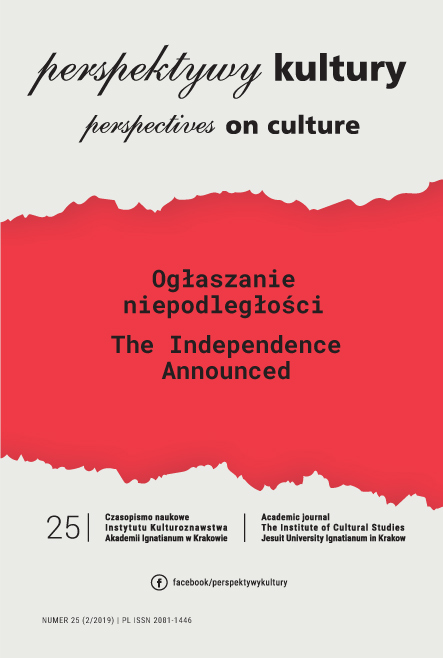Internet – pierwsze źródło (dez)informacji
Abstrakt
The Internet is the first medium in which controlling the content has become difficult or even impossible. One of its reasons is the fact that the Internet users – who so far were only passive recipients of media messages – have gained the possibility to create and distribute their own messages. Thus, they have become active participants of the participatory culture, in which it is difficult to distinguish between professional and amateur content. The boundaries between private and public domains have become blurred. The distribution of forces shaping public opinion has changed, because the content comes from large media corporations and nonprofessional creators alike.
The Internet message is characterized by instantaneous distribution, the ease of editing and modifying its content, and vagueness of authorship. These features make the Internet particularly susceptible to disinformation purposefully aimed at manipulating its users. The fact that every activity undertaken by the Internet users is recorded and analysed is also conducive to manipulation attempts, as the data obtained this way are used to shape their opinions and influence their decisions.
The aim of the article is to undertake a discourse on information and disinformation on the Internet in the context of the development of new digital communication tools. The article provides the examples of information manipulation, which could happen only in such an interactive and multimedia medium as the Internet.
Bibliografia
Anderson C.W., Downie L.Jr., Schudsonthe M., News Media. What Everyone Needs to Know, New York 2016.
Antosik M., Człowiek współczesny w obliczu manipulacji, “Warmińsko-Mazurski Kwartalnik Naukowy,” 1, 2014.
Bogdan W. et al., Cyfrowi Polacy – przyśpieszenie e-rewolucji, https://mckinsey.pl/publikacje/raport-cyfrowi-polacy-przyspieszenie-e-rewolucji/.
Campbell J.W., Not Likely Sent: The Remington – Hearts Telegrams, “Journalism & Mass Communication Quarterly,” 77, 2, 2000.
Dehaene S., Naccache L., Can One Suppress Subliminal Words?, “Neuron,” 52(3), 2006. Donath J., Identity and Deception in the Virtual Community in Communities in Cyberspace, in: Communities in Cyberspace, eds. P. Kollock, M. Smith, London 1999.
Greenstein S., Soccer Mom Messaging Is the Poetry of our Age, “IEEE Com-puter Society,” 29(4), 2009, https://www.researchgate.net/profile/Shane_Greenstein/publication/228495581Soccer_Momessaging_Is_the_Poetry_of_Our_Age/links/0c9605383505f9ba70000000.pdf.
Hall K.A., The authenticity of social-media performance: lonelygirl15 and the amateur brand of Young-Girlhood, “Women & Performance: a journal of feminist theory,” Vol. 25, No. 2, 2015.
Hatcher-Gallop R., Fazal Z., Oluseyi M., Quest for Excellence in a Wikibased World, 2009 IEEE International Professional Communica-tion Conference, Waikiki, 2009, https://www.academia.edu/10021988/ Quest_for_excellence_in_a_wiki-based_world.
Hofmokl J., Tarkowski A., Wikipedia – pospolite ruszenie encyklopedystów. Największa encyklopedia na świecie, http://www.ebib.pl/2006/73/hofmokl_tarkowski.php
Jabłońska M., Personalizacja internetu – zagrożenie czy naturalny proces rozwoju sieci?, “Com.press,” 2 (1), 2019.
Jachyra D., Trollowanie – antyspołeczne zachowania w internecie, sposoby wykrywania i obrony, “Zeszyty Naukowe Uniwersytetu Szczecińskiego,” 655, 2011.
Koczanowicz L., Lęk intymności, czyli mówienie prawdy w dobie internetu, “Kultura Współczesna,” 2(101)/2018.
Kupferschmidt K., Social media ‘bots’ tried to influence the U.S. election. Germany may be next, https://www.sciencemag.org/news/2017/09/social-media-bots-tried-influence-us-election-germany-may-be-next.
Lazer D.M.J. et al., The science of fake news. Addressing fake news requires a multidisciplinary effort, “Science,” 359, 6380, 2018.
Lorenc K., Wolność mediów a bezpieczeństwo państwa, “Krakowskie Studia Międzynarodowe,” XIII, 4, 2016.
Marwick A., Lewis R., Media Manipulation and Disinformation Online, Data & Society Research Institute, 2017, https://datasociety.net/output/media-manipulation-and-disinfo-online/.
Musiał E., Trolling jako przykład zagrożeń informacyjnych w cyberprzestrzeni, in: Bezpieczeństwo informacyjne w dyskursie naukowym, eds. H. Batorowska, E. Musiał, Kraków 2017.
Newman N., Fletcher R., Kalogeropoulos A., Kleis N.R., Reuters Institute Digital News Report 2019, https://reutersinstitute.politics.ox.ac.uk/sites/default/files/2019-06/DNR_2019_FINAL_1.pdf.
Olszewska E., Przekaz podprogowy w reklamie jako manipulacja i zagrożenie dla poczucia bezpieczeństwa konsumenta, “Zeszyty Naukowe WSOWL,” 2 (168), 2013.
Palczewski M., Selekcja informacji w mediach – zasady, wartości, manipulacje, “Naukowy Przegląd Dziennikarski,” 2, 2015.
Pawlak P., Charakter dyskusji politycznej na portalach informacyjnych. Studium przypadku, “Studia Europaea Gnesnensia,” 13/2016.
Salpeter L.R., Swirsky J.I., Historical and Legal Implications of Subliminal Messaging in the Multimedia: Unconscious Subjects, “Nova Law Review,” 36, 3, 2012.
Shao Chengcheng et al., The spread of fake news by social bots, 2017, https://www.andyblackassociates.co.uk/wpcontent/uploads/2015/06/fakenews-bots.pd.
Shu Kai et al., Fake News Detection on Social Media. A Data Mining Perspective, https://arxiv.org/pdf/1708.01967.pdf.
Singh M., Nayyar R., Psychology of Brand Creation and Management: Subliminal Advertising, “International Journal of Science and Research,” 6, 11, 2017.
Sobkowiak S., Prawda w Internecie. Czy katolickie portale internetowe mani-pulują informacjami?, “Teologia i Moralność,” Vol. 13, No. 2(24), 2018, p. 215.
Sriendra D.I., Abeywardena K.Y, The Use of Subliminal and Supraliminal Messages in Phishing and Spear Phishing based Social Engineering Attacks; Feasibility Study, The 13th International Conference on Computer Science & Education (ICCSE 2018), https://ieeexplore.ieee.org/document/8468681.
Sulej M., Reklama podprogowa jako forma manipulacji, “Warszawskie Studia Pastoralne,” 12, 2010.
Susser D., Roessler B., Nissenbaum H.F., Online Manipulation: Hidden In-fluences in a Digital World, 2018, http://dx.doi.org/10.2139/ssrn.3306006.
Szymielewicz K., Iwańska K., Śledzenie i profilowanie w sieci. Jak z klienta sta-jesz się towarem, 2019, https://panoptykon.org/sites/default/files/publikacje/panoptykon_raport_o_sledzeniu_final.pdf.
The 25 Most Influential People on the Internet, https://time.com/5626827/the-25-most-influential-people-on-the-internet/.
Weinberger J., Westen D., RATS, We Should Have Used Clinton: Subliminal Priming in Political Campaigns, “Political Psychology,” Vol. 29, No. 5.
Yang K.-Ch., Varol O. et al., Arming the public with artificial intelligence to counter social bots, “Human Behavior and Emerging Technologies,” 1, 1, 2019.
Zawojski P., Sztuka obrazu i obrazowania w epoce nowych mediów, Warszawa 2012.
Copyright (c) 2020 Perspektywy Kultury

Utwór dostępny jest na licencji Creative Commons Uznanie autorstwa – Bez utworów zależnych 4.0 Międzynarodowe.
Autor, zgłaszając swój artykuł, wyraża zgodę na korzystanie przez Wydawnictwo Uniwersystet Ignatianum z utworu na następujących polach eksploatacji:
- utrwalania utworu w formie papierowej, a także na nośniku cyfrowym lub magnetycznym;
- zwielokrotnienia utworu dowolną techniką, bez ograniczenia ilości wydań i liczby egzemplarzy;
- rozpowszechniania utworu i jego zwielokrotnionych egzemplarzy na jakimkolwiek nośniku, w tym wprowadzenia do obrotu, sprzedaży, użyczenia, najmu;
- wprowadzenia utworu do pamięci komputera;
- rozpowszechniania utworu w sieciach informatycznych, w tym w sieci Internet;
- publicznego wykonania, wystawienia, wyświetlenia, odtworzenia oraz nadawania i reemitowania, a także publicznego udostępniania utworu w taki sposób, aby każdy mógł mieć do niego dostęp w miejscu i czasie przez siebie wybranym.
Wydawca zobowiązuje się szanować osobiste prawa autorskie do utworu.





